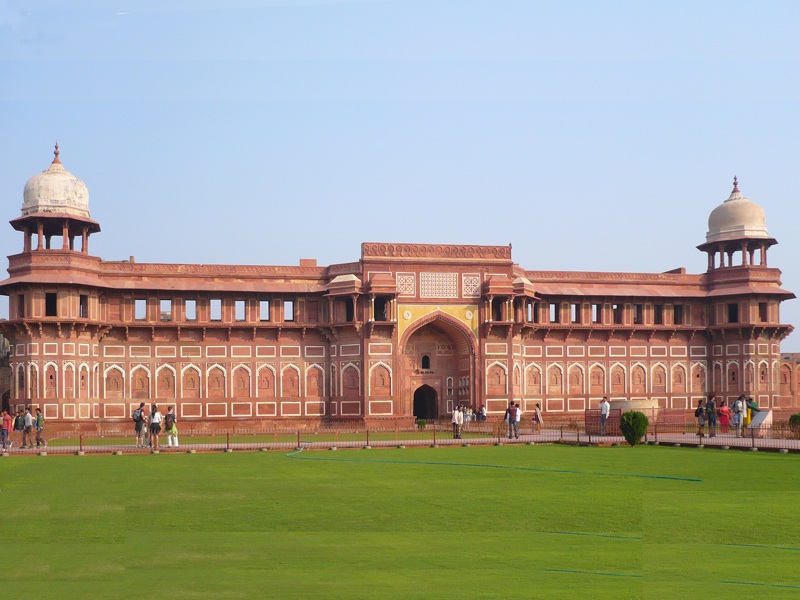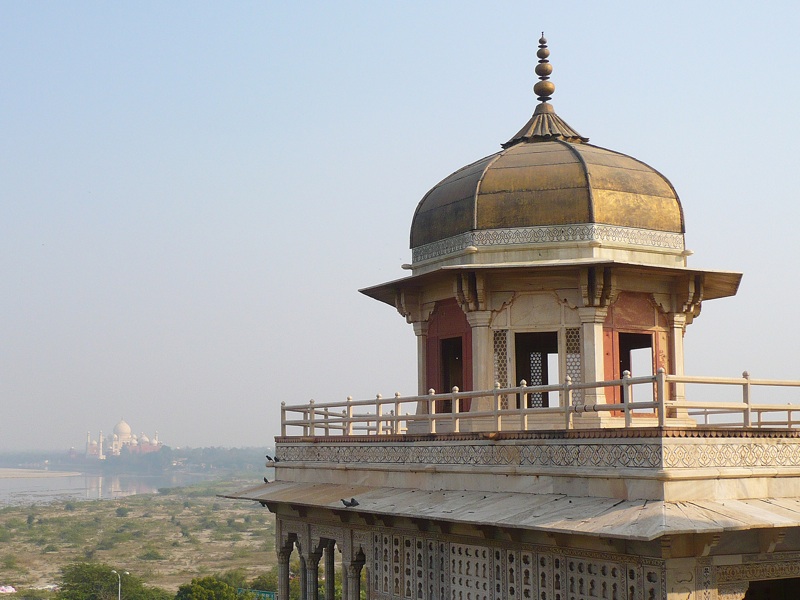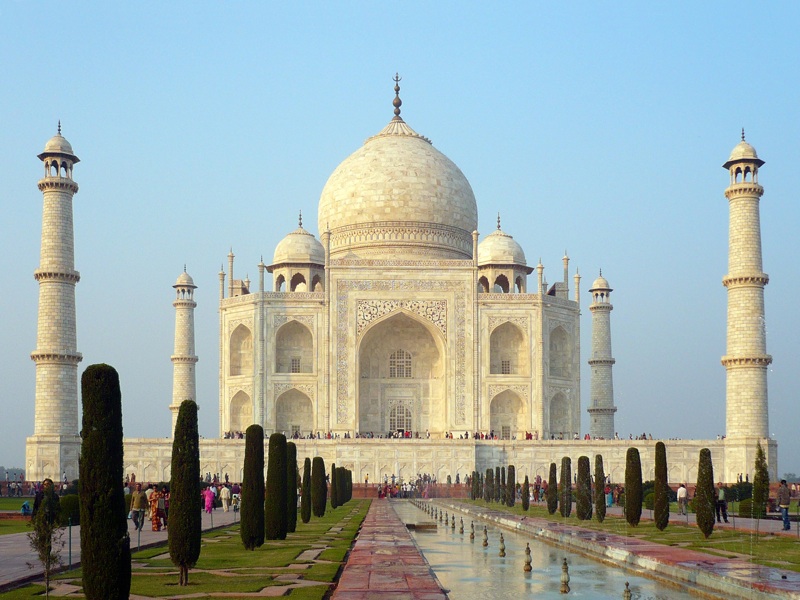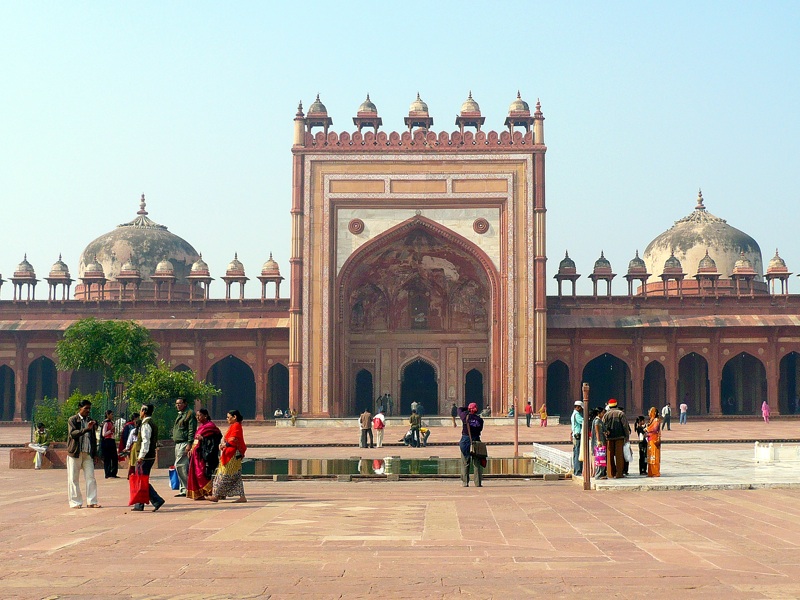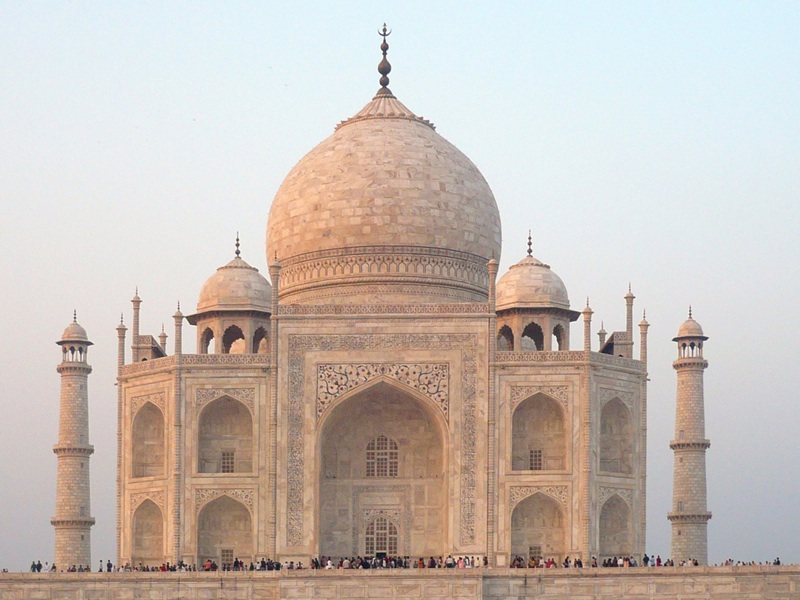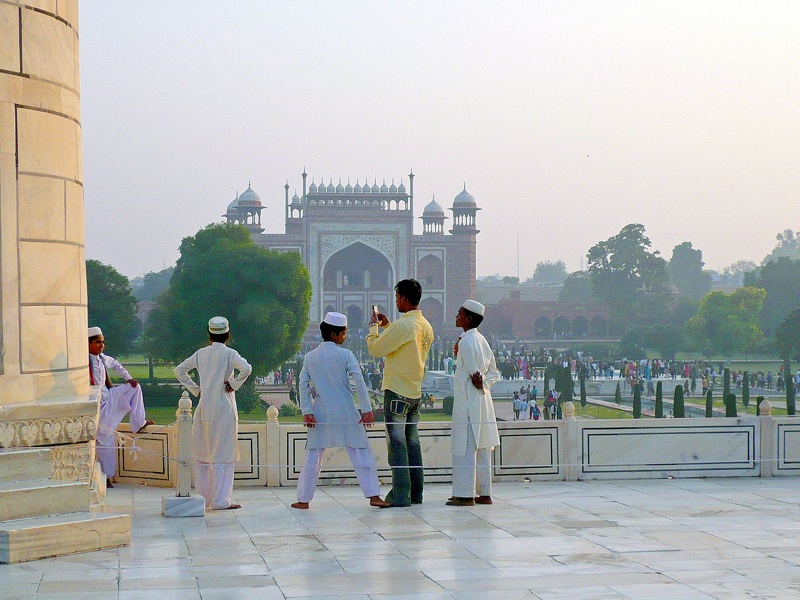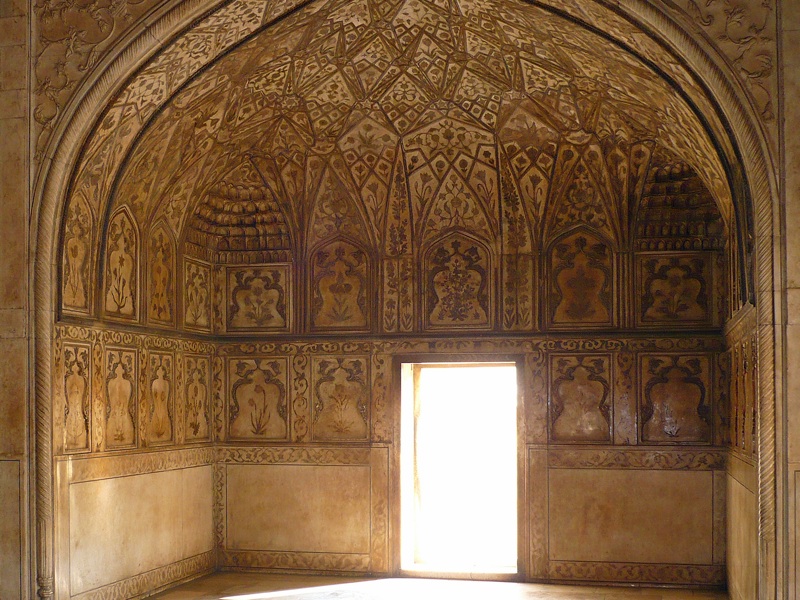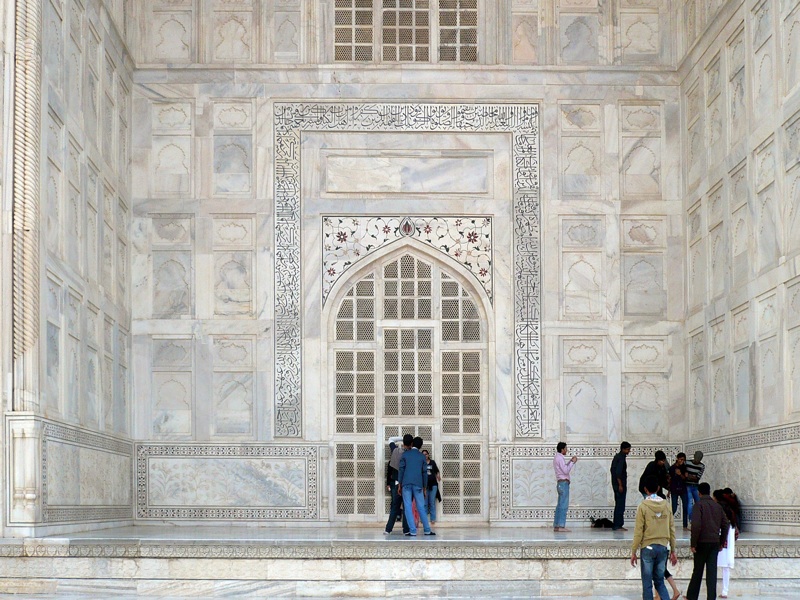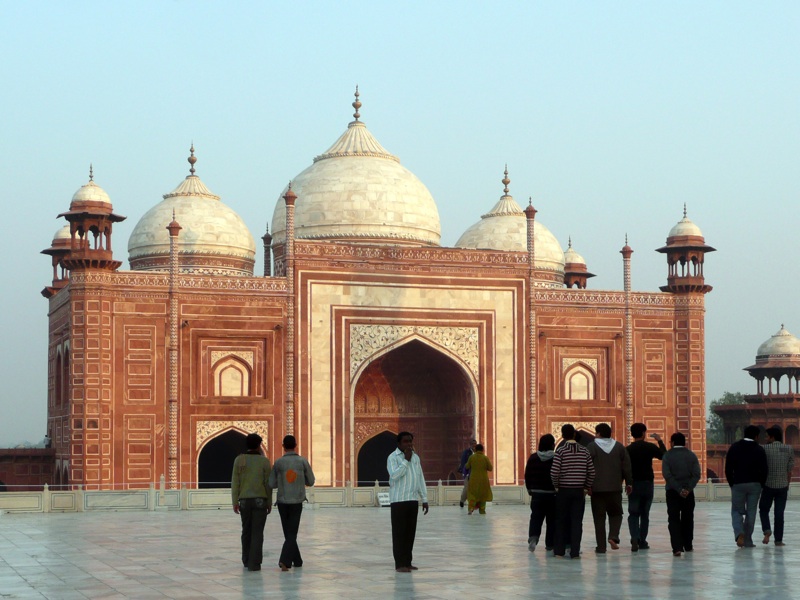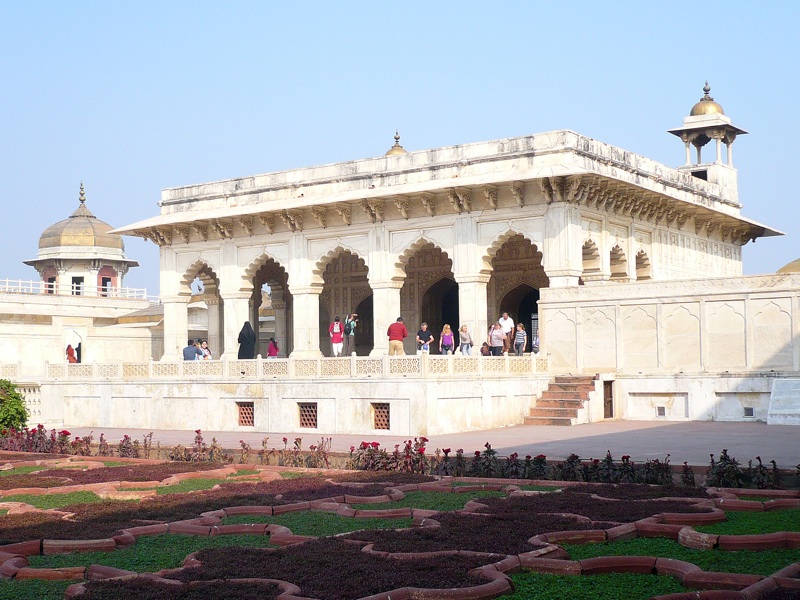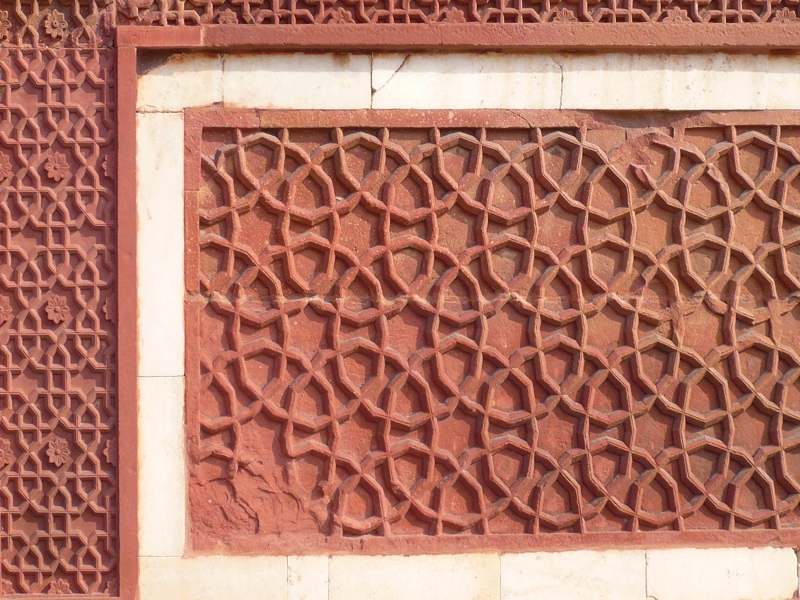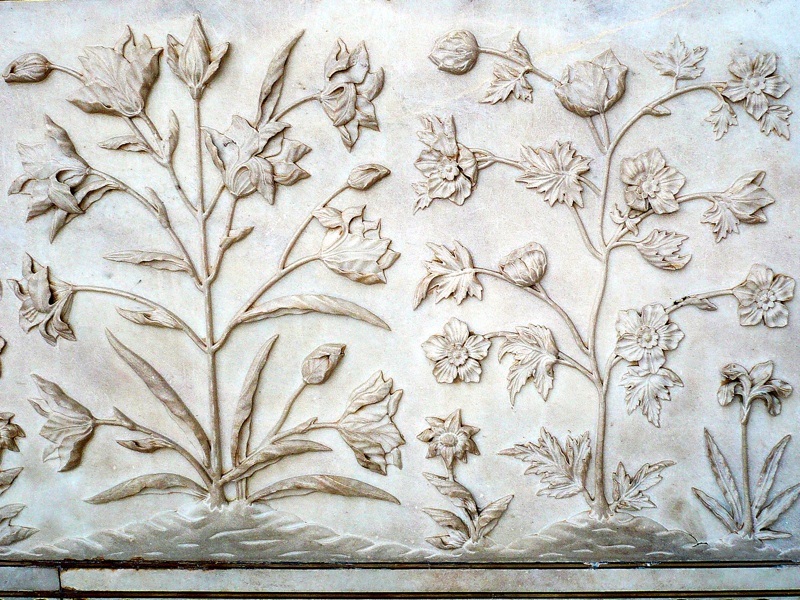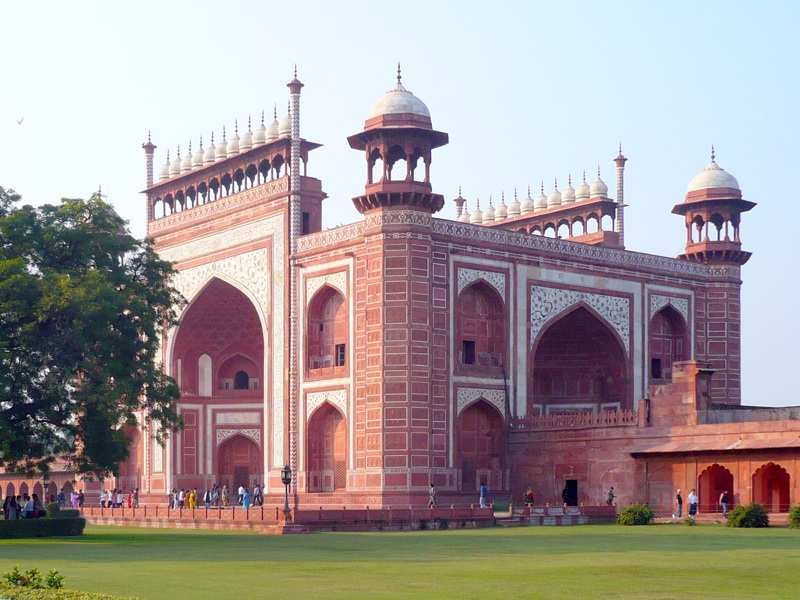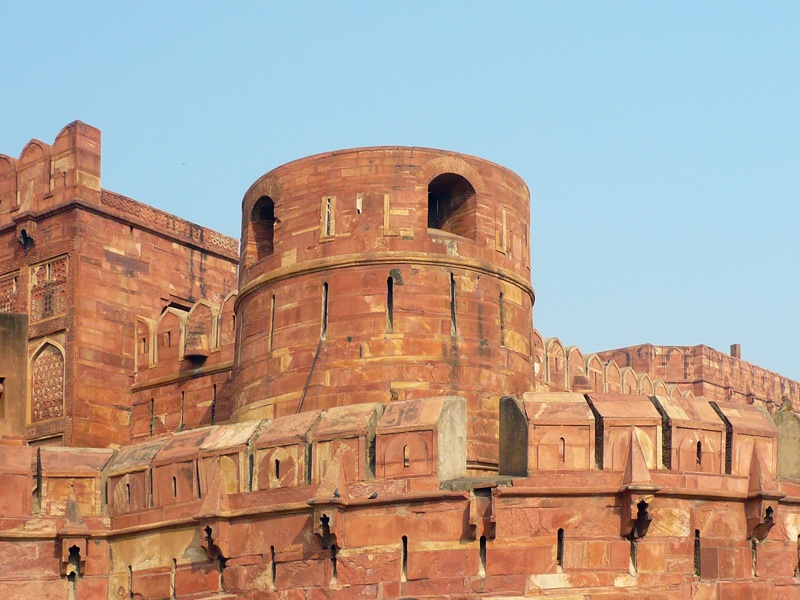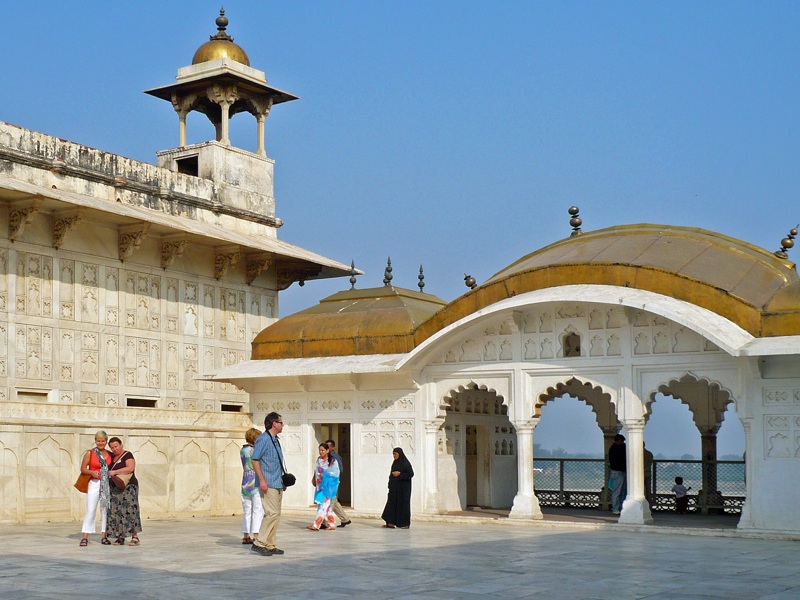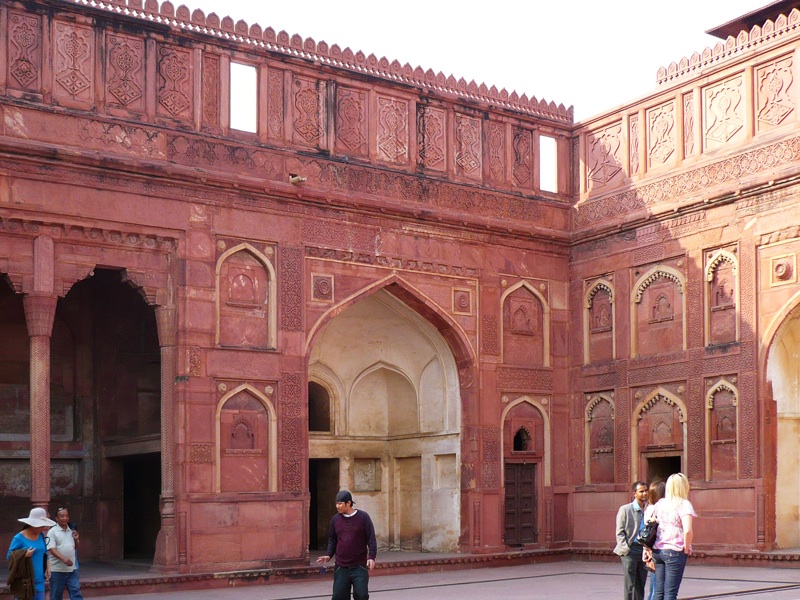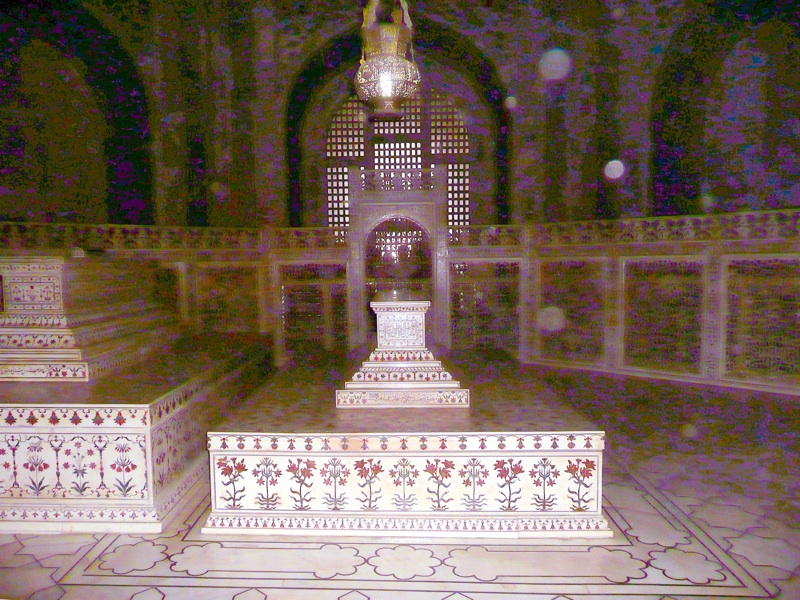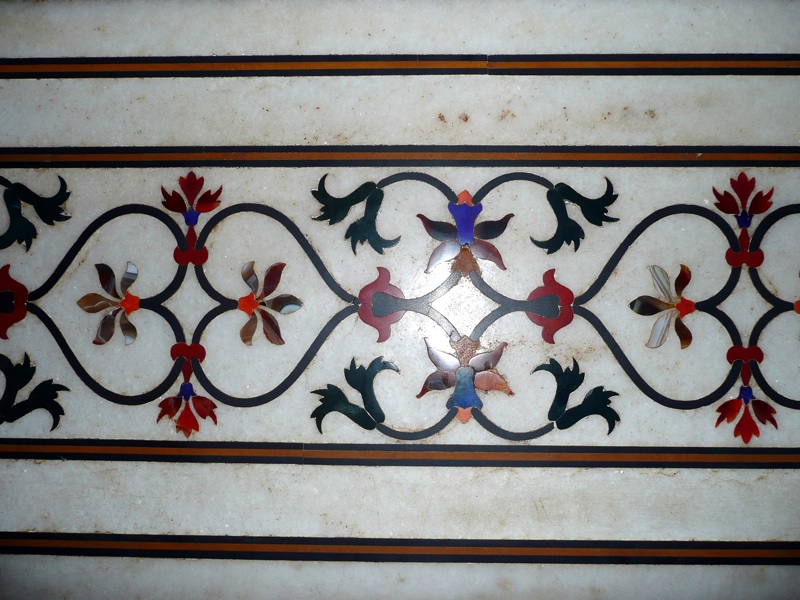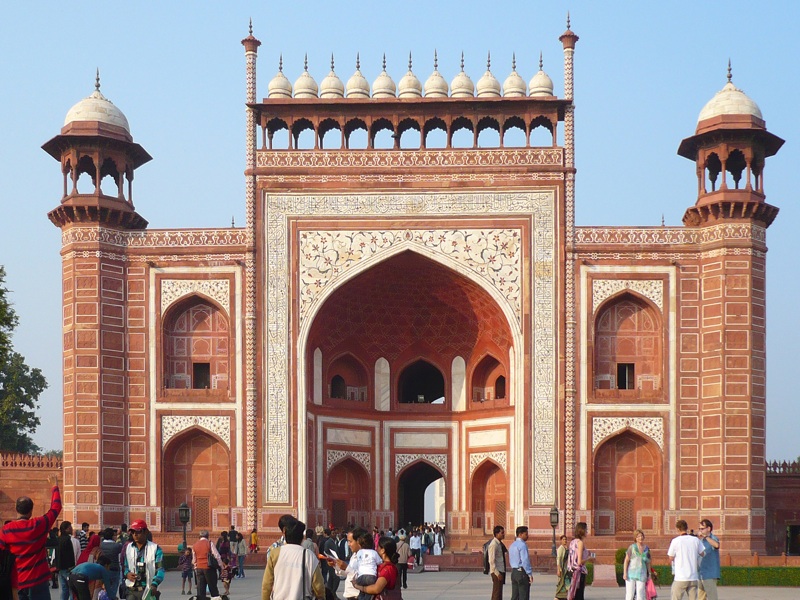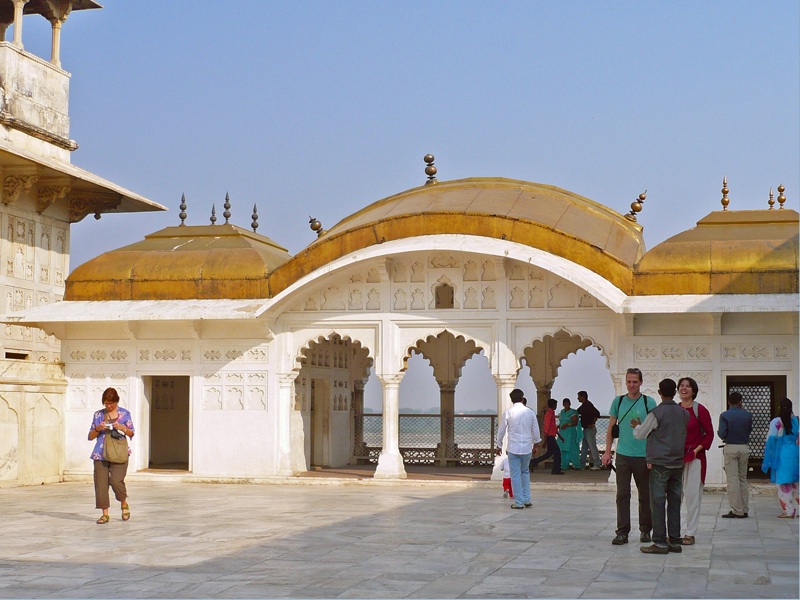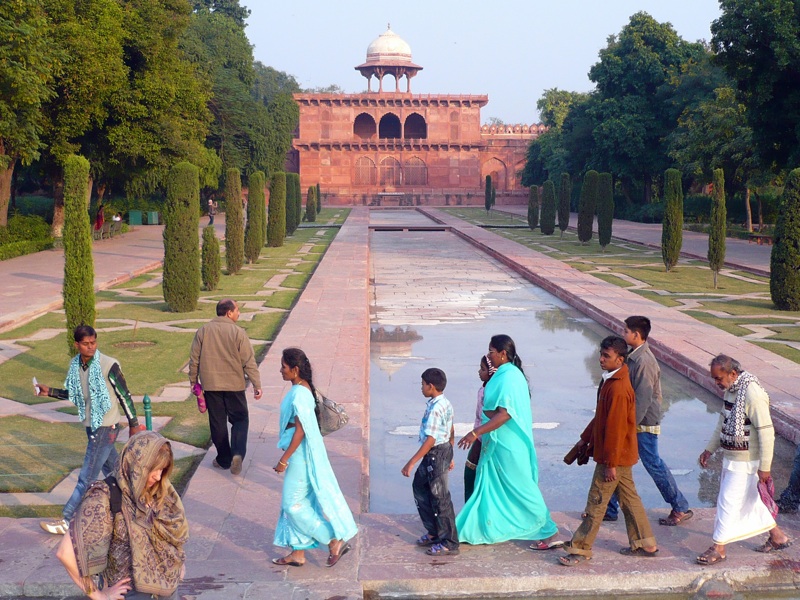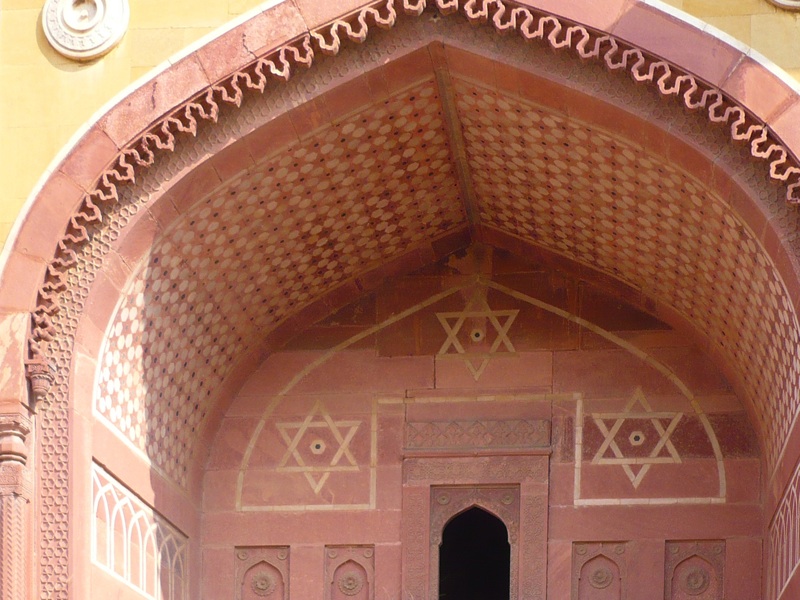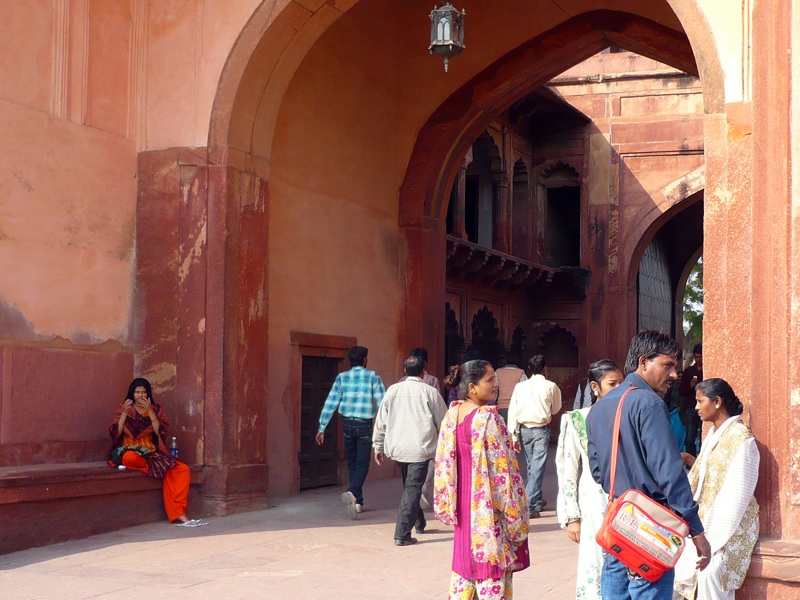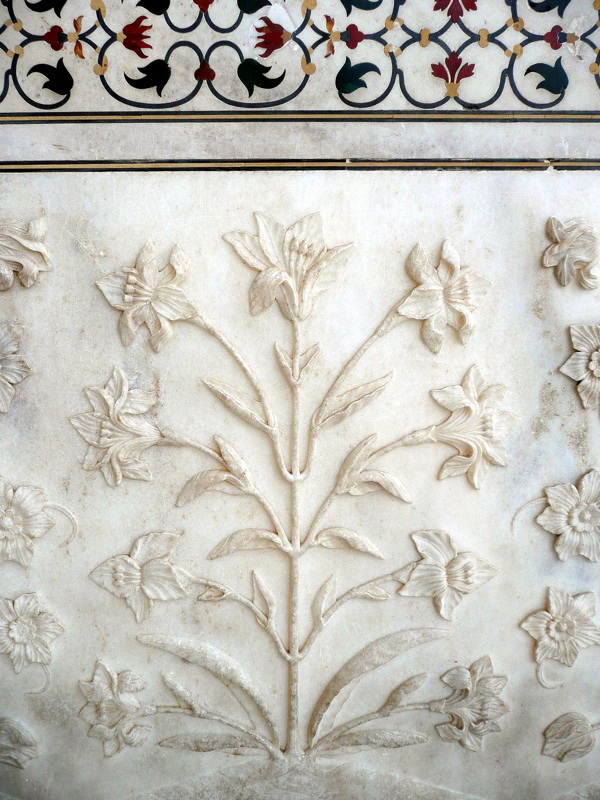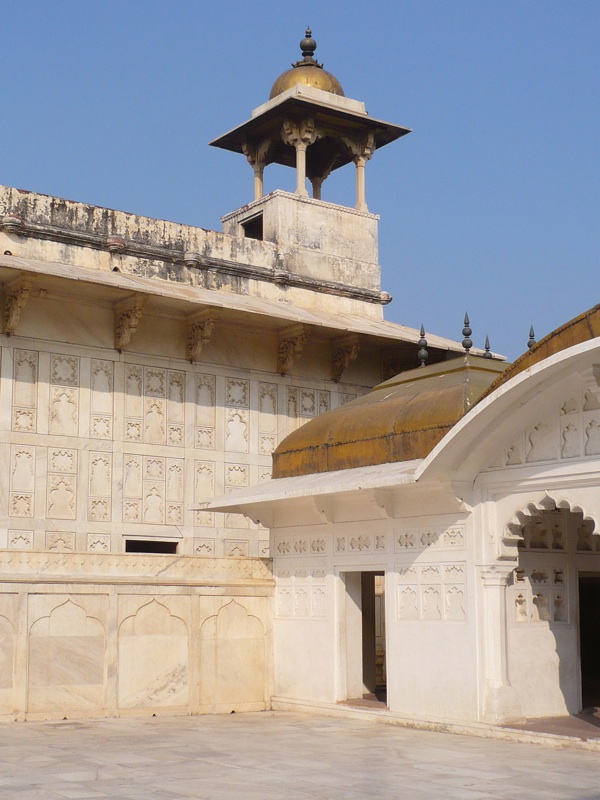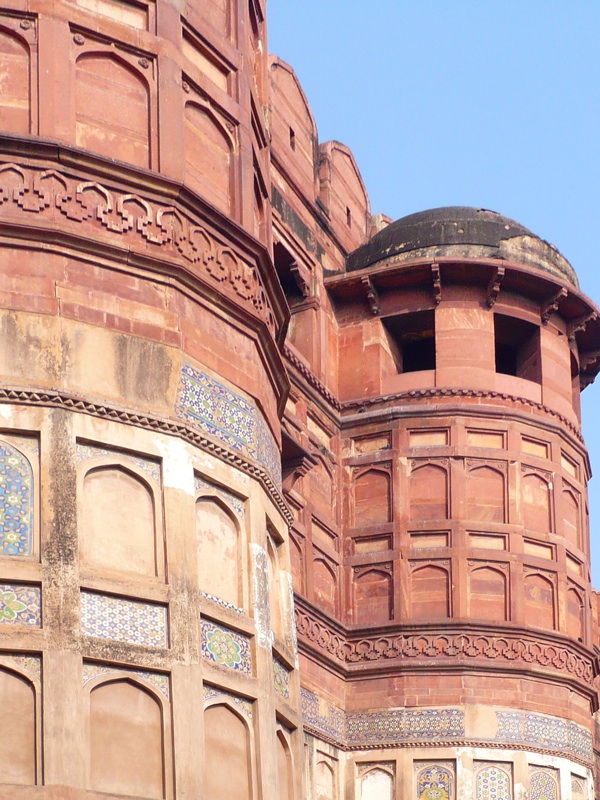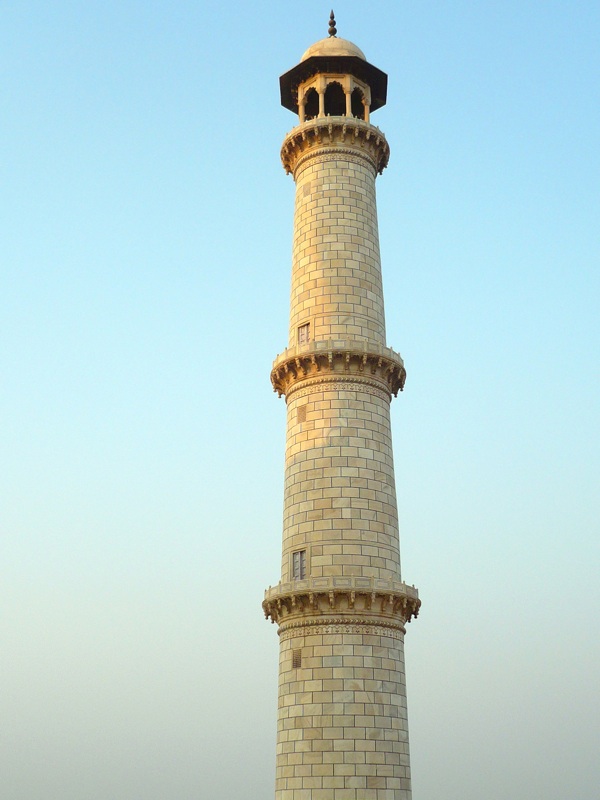Photo gallery
 , 363 km west of the state capital, Lucknow
, 363 km west of the state capital, Lucknow  (➤ map)(➤ map). Today Agra has approximately 1,700,000 inhabitants. It is an important transportation hub and university town. As the former capital of the Great Mughal Empire, it is an extremely important tourist center - the monuments of the highest class include the mighty fortress built by Akbar the Great, the famous Taj Mahal mausoleum, and the building complex located less than 40 km west of Agra, known as Fatehpur Sikri . The nearest airport, Kheria Airport, is approx. 5 km south-west of the center; there is also a railroad to the city.
(➤ map)(➤ map). Today Agra has approximately 1,700,000 inhabitants. It is an important transportation hub and university town. As the former capital of the Great Mughal Empire, it is an extremely important tourist center - the monuments of the highest class include the mighty fortress built by Akbar the Great, the famous Taj Mahal mausoleum, and the building complex located less than 40 km west of Agra, known as Fatehpur Sikri . The nearest airport, Kheria Airport, is approx. 5 km south-west of the center; there is also a railroad to the city.Different sources give different information as to the time when the city was founded. It seems certain that it was still in the first millennium CE, although Agra became an important city only in the 16th century, first, when in 1506 the Muslim rulers of the region moved here the capital of the so-called Delhi Sultanate, and then, when they were defeated in 1526 by Babur, the founder of the Mughal dynasty, who also established Agra as the capital of his state, established in the conquered territories of northern India. The heyday of the city fell during the reign of Babur's grandson, Akbar the Great [Jalaluddin Muhammad Akbar], who lived in the years 1542-1605, the third emperor of the Mughal dynasty, an outstanding political leader and military commander, but also known as an enlightened and tolerant ruler, also in religious matters. When Akbar took power in 1556 after the early death of his father, Humayun, the best period in the city's history came - it became one of the largest and richest metropolises in the world at that time (with approx. 750,000 inhabitants).
Although in 1571 Akbar started building a new capital at the site of the village of Sikri, about 40 km west of Agra (see Fatehpur Sikri) - but already in 1578 the newly built city, which was running short of drinking water, was abandoned. The capital was moved briefly to Lahore, then again to Agra, from where the Mughal empire was ruled first by Akbar's son, Jahangir, then grandson, Shahjahan. Eventually, the son of the latter, Aurangzeb, a fanatical follower of Islam, moved the capital to Delhi in 1658. Agra then lost its former political significance, although it remained an important commercial and cultural center. In 1803, Agra was conquered by the British East India Company and from then on, until India gained independence, the history of the city was already connected with the history of British India.
The most important monuments of Agra are the so-called Red Fort
 , located on the Jamuna, east of the center of today's Agra, and the famous Taj Mahal mausoleum
, located on the Jamuna, east of the center of today's Agra, and the famous Taj Mahal mausoleum  , a little further east.
, a little further east.The entire complex, partly built of red sandstone and partly of white marble, is a complex of buildings enclosed within huge double battlemented walls, up to 20 meters high and approximately 2.5 kilometers long. The whole thing is surrounded by a moat.
The entrance to the Red Fort today leads through the monumental Amar Singh gate
 . The most important buildings inside the fortress are:
. The most important buildings inside the fortress are:- Jahangiri Mahal
 - probably the largest of the palaces inside the fortress walls, built by Akbar in the years 1565-1569;
- probably the largest of the palaces inside the fortress walls, built by Akbar in the years 1565-1569;
- Diwan-i-Am
 – the public audience hall, where the emperor accepted the reports of officials and considered state matters (apparently in this room there used to be the famous so-called "Peacock Throne", later brought by Aurangzeb, Akbar's great-grandson, to Delhi, and in 1739 Nadir robbed by the Persians during the Shah's invasion of Iran; however, according to some sources, the throne stood not here but in the private audience hall);
– the public audience hall, where the emperor accepted the reports of officials and considered state matters (apparently in this room there used to be the famous so-called "Peacock Throne", later brought by Aurangzeb, Akbar's great-grandson, to Delhi, and in 1739 Nadir robbed by the Persians during the Shah's invasion of Iran; however, according to some sources, the throne stood not here but in the private audience hall);
- Diwan-i-Khas
 – a private audience hall, where the ruler received diplomats and the most important dignitaries; here the so-called Takht-i-Jahangir, made in 1602 of black onyx, the throne of Jahangir, son of Akbar, until 1610 remaining in the fortress of Allahabad, where 8 years earlier, while Akbar was still alive, it was executed on the order of the future emperor at the time he resided in Allahabad rebellious against his father;
– a private audience hall, where the ruler received diplomats and the most important dignitaries; here the so-called Takht-i-Jahangir, made in 1602 of black onyx, the throne of Jahangir, son of Akbar, until 1610 remaining in the fortress of Allahabad, where 8 years earlier, while Akbar was still alive, it was executed on the order of the future emperor at the time he resided in Allahabad rebellious against his father;
- Musamman Burj
 - a palace in the shape of an octagonal tower with a terrace, from where you can perfectly see the Taj Mahal (Musamman Burj was the place where Shahjahan, imprisoned by his son Aurangzeb, spent the last 8 years of his life and died);
- a palace in the shape of an octagonal tower with a terrace, from where you can perfectly see the Taj Mahal (Musamman Burj was the place where Shahjahan, imprisoned by his son Aurangzeb, spent the last 8 years of his life and died);
- Khas Mahal
 – private residence of the rulers, made of white marble, considered to be the most beautiful palace in the Red Fort; particularly noteworthy is the room located between Jahangiri Mahal and Khas Mahal, called the Palace of Mirrors, equipped with a glass mosaic decoration, serving as a royal wardrobe.
– private residence of the rulers, made of white marble, considered to be the most beautiful palace in the Red Fort; particularly noteworthy is the room located between Jahangiri Mahal and Khas Mahal, called the Palace of Mirrors, equipped with a glass mosaic decoration, serving as a royal wardrobe.
- Moti Masjid
 – made of marble, considered to be one of the most beautiful mosques in India;
– made of marble, considered to be one of the most beautiful mosques in India;
- Nagina Masjid
 - supposedly intended for the ladies of the court;
- supposedly intended for the ladies of the court;
- Anguri Bagh
 - a geometrically arranged garden consisting of 85 flower segments, with a fountain in the middle, divided into four parts separated by alleys.
- a geometrically arranged garden consisting of 85 flower segments, with a fountain in the middle, divided into four parts separated by alleys.
Ustad Ahmad Lahauri is believed to be the main designer of the mausoleum, although a whole team of architects and builders and (supposedly) 20,000 craftsmen worked on it.
 made of red sandstone. A wide canal leading from the entrance to the actual mausoleum
made of red sandstone. A wide canal leading from the entrance to the actual mausoleum  it is the axis of symmetry of the whole; the mausoleum is 300 meters away from the marble roads that run on both sides of the canal.
it is the axis of symmetry of the whole; the mausoleum is 300 meters away from the marble roads that run on both sides of the canal.The tomb, 74 m high, stands on a pedestal. It is topped with a 35 m high central dome, onion-shaped, with a lotus-shaped top; this one, in turn, is surrounded by four smaller domes at the corners, repeating the shape of the main dome. At the corners of the larger square covering the pedestal on which the tomb stands, there are minarets over 40 meters high. The whole is extremely richly decorated, inlaid with ivory and semi-precious stones, partially covered with mosaics and verses from the Koran. Inside, tourists can see cenophates, symbolic tombs of Mumtaz Mahal (in the center) and (next to) Shahjahan himself; their real graves are in the basement of the mausoleum.
There is a mosque
 to the west of the tomb ; to the east, at the same distance, there is a twin building serving as a guest house
to the west of the tomb ; to the east, at the same distance, there is a twin building serving as a guest house  .
.
Neighborhoods
In the immediate vicinity of Agra, apart from the Red Fort and Taj Mahal, it is worth seeing the I'timad-ud-Dalauh mausoleum; a little further is to Fatehpur Sikri and to the tomb of Akbar the Great.
- I'timad-ud-Dalauh - is the tomb of the father-in-law of Emperor Jahangir, who served as vizier at his court, from the years 1622-28. The marble, ornate tomb, located 4.5 kilometers northeast of Agra, is much smaller than the Taj Mahal, but some sources say it was a model for architects and builders of the latter.
- Fatehpur Sikri - is an architectural complex located 37 km west of Agra, built by Akbar the Great in the early 1680s as the new capital of the empire, but soon abandoned due to lack of drinking water; next to the Red Fort and Taj Mahal, it is the third "must-see" tourist destination in the Agra region.
- About 10 km north of Agra, near the highway to Delhi, is the tomb of Akbar the Great, surrounded by a large garden. The construction was supposedly started by Akbar himself, but was completed by his son, Jahangir. Nearby you can also see the tomb of one of Akbar's wives, the mother of Jahangir, Mariam Zammani.

